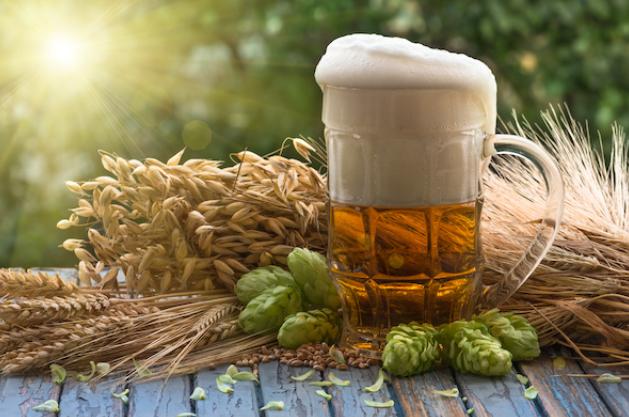The fermentation process of beer is highly dependent on several factors, such as the type of malt used, the brewing method employed, the yeast strain used, and the temperature at which the fermentation process takes place.
Fermentation is a complex process, but it doesn’t have to be complicated. With FarmSteady’s all-in-one kits, you can quickly learn how to ferment drinks like beer.
The fermentation process involves factors such as temperature, yeast type, timing, and oxygen levels – understanding these factors will help you produce high-quality beer consistently.

If you’re ready to start brewing your beer at home, try FarmSteady’s all-in-one kits and see how easy it can be!
What is Beer Fermentation?
Beer fermentation is essential to brewing, but what exactly occurs to your beer during this process?
Using yeast converts glucose into ethanol and carbon dioxide gas in roughly equal amounts. Top fermentation, which results in ales, and bottom fermentation, which results in lagers, are the two primary fermentation techniques used in brewing.
The Science Behind the Fermentation Process Of Beer
Fermentation is a process that has been around for centuries, used to create delicious foods and beverages like bread, cheese, yogurt, beer, and wine. But what is it about the fermentation process that makes it so important?
Well, it all comes down to the science behind fermentation. This blog post will explore some critical factors that affect fermentation and how they contribute to its success.
Temperature
Temperature plays a vital role in fermentation because it impacts the environment where the microorganisms responsible for fermentation can survive.
Different microorganisms prefer different temperatures, so if your recipe recommends a specific fermentation temperature range, you must adhere to it closely. In general, warmer temperatures speed up the fermentation process, while cooler temperatures slow it down.
The temperature at which fermentation takes place plays a significant role in determining the outcome of the finished beer. Different types of fermentations require different temperatures to achieve optimal results.
For example, lactic acid bacteria (the bacteria responsible for fermenting milk and making yogurt) thrive in warmer temperatures (around 45-50°C), while Saccharomyces cerevisiae (the yeast used for making beer and wine) prefer cooler temperatures (between 15-20°C).
It’s essential to ensure you are using the correct temperature range for your specific fermentation type if you want the best results.
Type of Yeast
The type of yeast used in fermentation is another essential factor to consider. Different yeasts have different characteristics and can produce a variety of flavors and aromas. Different yeasts will achieve the desired flavor profile depending on the beer style you are brewing.
RELATED: Gluten Free Beer Brewing – Sorghum Malt Review
pH Balance
The pH or acidity of your ingredients will also affect how quickly and efficiently your recipe ferments. Most recipes require a specific pH level for the microorganisms to thrive and produce optimal results.
If your ingredients don’t meet these criteria, you may need to adjust their acidity levels before proceeding with the fermentation process.
The pH level of your fermented product also affects its success. Different microorganisms have different optimal pH ranges—some prefer acidic conditions, while others thrive in alkaline environments.
For example, lactic acid bacteria prefer a lower pH level between 4-5, while Saccharomyces cerevisiae prefers a higher range between 5-7.
Suppose you don’t maintain your pH within these ranges. In that case, you risk an unsuccessful fermentation due to inhibited microbial activity or off flavors due to changes in organic acid production by microorganisms in your product.
Oxygen Supply
Oxygen supply is another factor that can impact fermentation because some bacteria require oxygen while others do not. Suppose there’s too much or too little oxygen present in your environment.
In that case, it can interfere with the growth of certain bacteria species, which will ultimately affect your final product’s taste and texture. It’s crucial to ensure enough oxygen circulation throughout your workspace when fermenting any food or beverage item.
Another critical factor in controlling fermentation is oxygen levels. While some types of fermentation can occur with minimal oxygen (like anaerobic fermentation), other types require oxygen for successful completion (known as aerobic fermentation).
In general, oxygen is necessary for yeast cells to produce alcohol during beer and wine production; too little oxygen can lead to poor flavor development or even cause specific processes like carbonation or clarification to fail.
On the other hand, too much oxygen can cause undesirable flavors or aromas in your finished product. It’s essential to monitor your oxygen levels carefully during fermentation if you want consistent results every time.
Primary Fermentation
The beer fermentation process’ initial step is known as primary fermentation. Beer yeast strains will begin to ferment at this time. Beers typically ferment for two weeks, but different beer styles have varying times.
Secondary Fermentation
This process is known as secondary fermentation, when a brewer transfers the beer from the primary fermentation vessel to a different vessel than the one used to initiate the fermentation process.
Secondary fermentation is essential if you want your beer to age and ferment for an extended period but are concerned about the yeasts settling out too much.
What Takes Place When Beer Ferments?
While the fermentation vessel still feels empty, beer yeast is introduced to begin the fermentation process. After the fermentation process, the liquid is known as “Green Beer,” and yeast has transformed the sugary fermenting wort into authentic beer by producing alcohol, a variety of flavors, and carbon dioxide (which is utilized later in the brewing process to carbonate the beer).
RELATED: Proven Ways To Chill Your Beer Fast
Conclusion
The fermentation process of beer and wine production is a complex process that requires careful attention to detail. Fermentation is a challenging process that requires careful attention to detail for success.
Temperature, oxygen, and pH levels are essential in controlling how well a fermented product develops its flavor and aroma profiles and maintaining consistency from batch to batch over time.
Understanding these key factors will help you produce high-quality fermented products every time! Whether you’re looking into home-brewing beer or making homemade cheese – understanding these factors can help ensure that your final product turns out just right!
Read Next: How to Filter Beer, The Benefits of Drinking Sour Beer and 7 Ways To Cool Beer Without A Fridge




